Types Of Oyster Mushrooms (Top Types You Need To Know)
You find them in farmers markets, strutting their stuff in beautiful, self-like bouquets. Or masquerading as meat in Asian food. Chewy or crispy, thick or delicate, they’re a culinary delight that’s hard to ignore.
What are they?
Oyster mushrooms, of course!
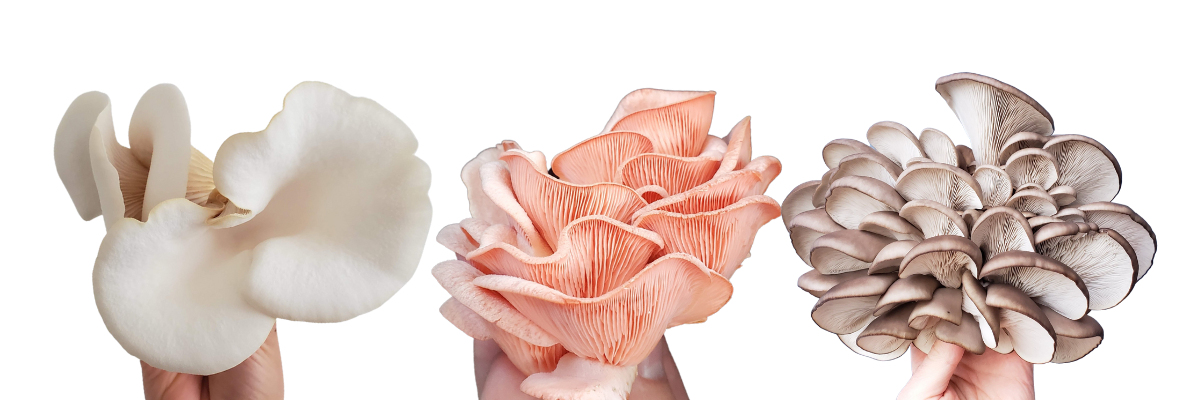
Scientifically categorized as Pleurotus sp, oyster mushrooms have a fan- or ear-like shape that somewhat resembles their sea-dwelling namesakes.
The classic ‘shroomy combination of cap and gills makes them easy to spot on dead and dying hardwood trees in various climates around the world.
But did you know there’s more than one type of oyster mushroom? These tasty fungi come in several varieties, each with its own characteristics and personality.
Fun fact: Sometimes oyster mushrooms are carnivores! The hyphae (filaments on the mycelium) attract both bacteria and little worms known as nematodes, which the mushrooms then paralyze and feed on.
Meet the Oyster Mushroom Family
Whether you’re looking for a new treat for your next kitchen experiment or are itching to try your hand at growing, the Pleurotus genus is worthy of exploration.
There are actually over 200 species of Pleurotus, but these five popular varieties are most likely to be cultivated and sold.
Yellow Oyster
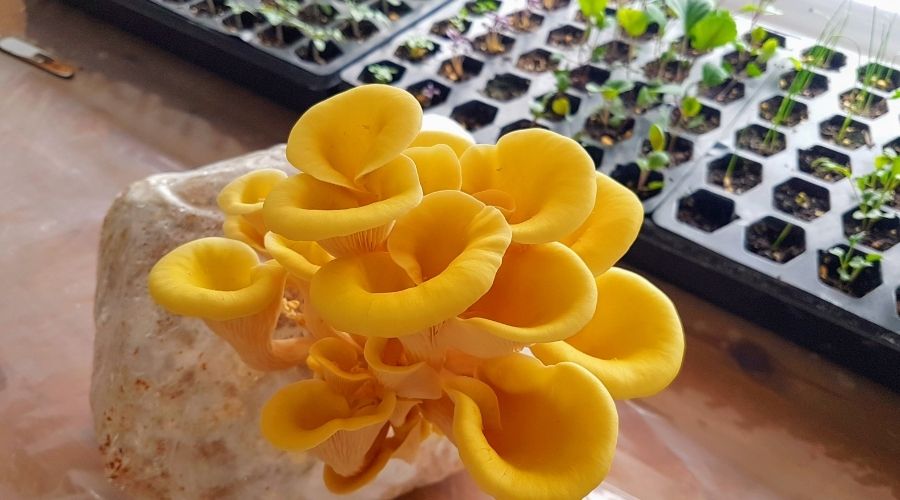
Pleurotus citrinopileatus, known as the yellow or golden oyster mushroom, is a delicate, eye-catching variety. The caps tend to be on the small side, ranging from 20 mm to 65 mm (3/4 inch to 2 1/2 inches) across and sport a beautiful yellow color.[1]
Although it grows quickly, Pleurotus citrinopileatus isn’t built for the mass market.
It doesn’t travel well, and too much handling can damage the caps, causing them to break or tear. That’s why you see them almost exclusively at farmers markets in spring and summer.
Fortunately, this variety is easy to grow at home. It doesn’t require a lot of oxygen and will flourish on a variety of substrates.
It used to be the case that you weren’t at all likely to see these in the wild. But more recently, Yellow Oysters are starting to show up in huge numbers throughout the US. It is theorized that the increased popularity of cultivation at small scale farms has allowed this species to “escape the farm” and overtake native decomposers.
Yellow Oysters might soon even be considered an invasive species in the US. There is a mycologist at the University of Wisconsin (Andrea Bruce) that is looking at this right now. Check out her research here.
Cooking with Yellow Oyster Mushrooms
Pleurotus citrinopileatus doesn’t have a standout flavor, but like most mushrooms, it will take on the taste of any spices or sauces used with it. Cook your mushrooms longer in soups or stews to get the fullest flavor, or turn up the heat and make them crispy for a unique texture in salads and pasta dishes!
Pink Oyster
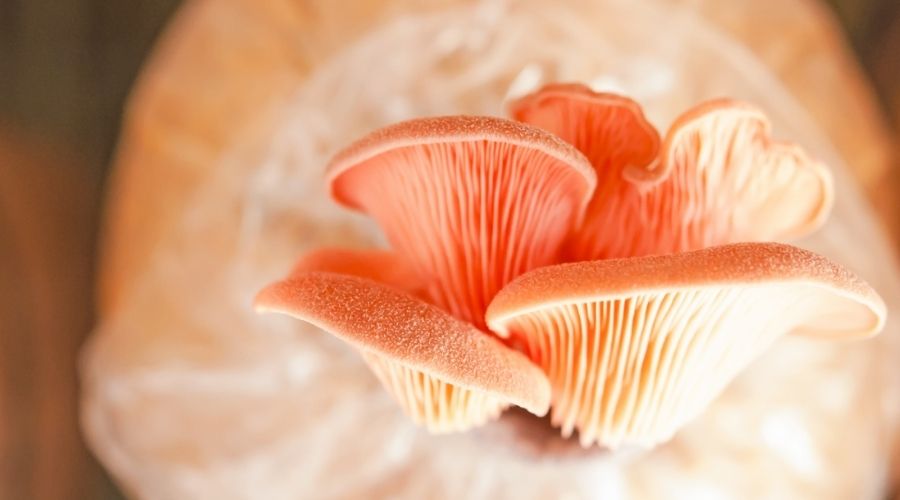
The the bright pink color of Pleurortus djamor conjures up mental images of flowers, flamingos and salmon.
Delicate like the first and textured somewhat like the third, this variety of oyster mushroom strikes quite the figure in market stalls during warmer months.
Pleurortus djamor grows quickly but doesn’t last long after harvest. Being a native of Indonesia and similar tropical locales, it’s also quite partial to hot weather and will thrive at temperatures in excess of 30°C (86°F). If temperatures drop too low during the growth cycle, the mycelium will die.
Growing conditions dictate the thickness of the caps and whether or not a short stem appears. Caps grow anywhere between 2 cm and 5 cm (3/4 inch to 2 inches) and give off a strong umami scent.
In addition to having a short shelf life, pink oyster mushrooms don’t transport well. If you see them, grab them while you can to enjoy the meaty, chewy texture! However you use them—in soups, stews or pasta dishes—make sure you cook them well to bring out the flavor.
Although they most closely resemble seafood, they can also be cooked to a crisp as a plant-based substitute for bacon.
Recipe to Try: Vegan Pink Oyster Mushroom “Bacon Bits”
Blue Oyster
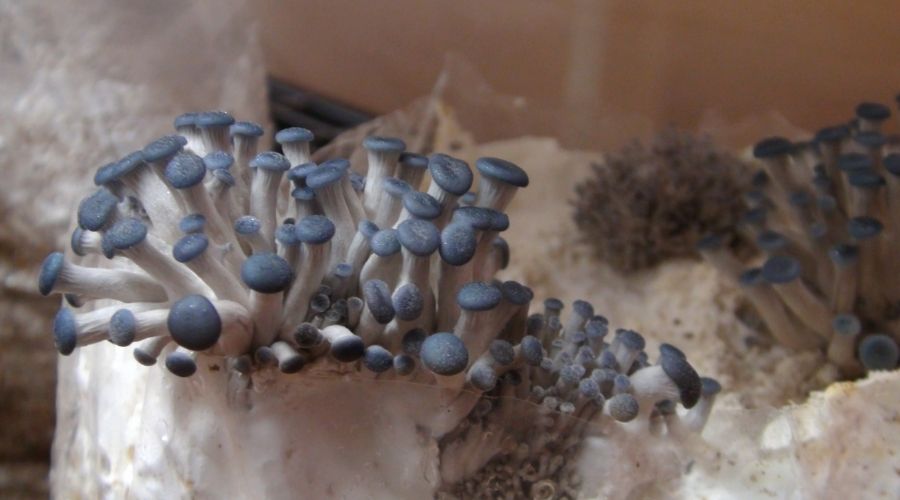
Unlike its pink cousin, the blue oyster mushroom—Pleurotus ostreatus var. columbinus– is a fan of cold weather. The colder the temperatures when the fruiting body emerges, the more intense the blue color. Commonly found in the wild all over North America, the blue oyster thrives in temperatures between 7°C and 18°C (45°F to 65°F).
One unique challenge of growing this mushroom at home is its high oxygen requirement.
Too much carbon dioxide produces a mushroom with a thick stem and tiny cap that lacks the vibrant hue characteristic of this variety.
Under the right conditions, though, this mushroom fruits quickly and produces caps that are most vibrant in the early stages of growth. The earthy, rich flavor makes for a good meat substitute. The stems can be a little on the chewy side, so chop them small and let them cook for a bit before adding the caps.
King Oyster
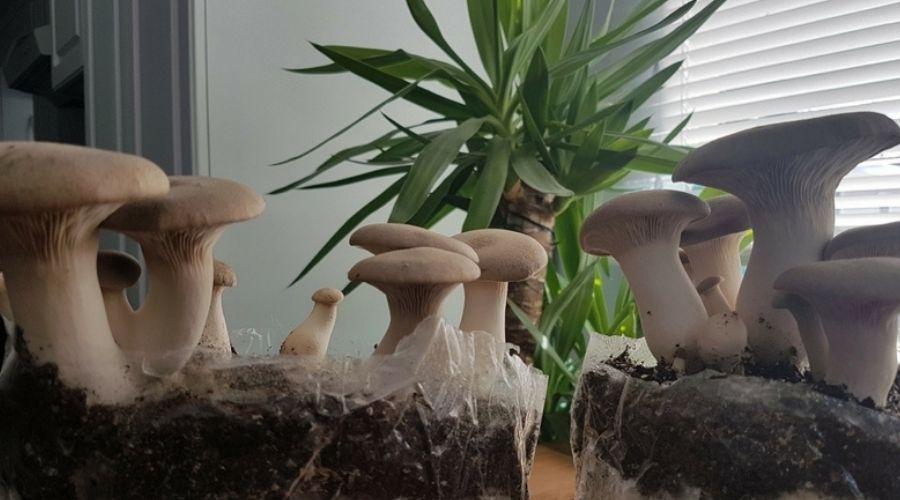
Pleurotus eryngii isn’t called the king for nothing.
Its large, thick stems and small caps stand out from the crowd at specialty stores and Asian markets. In fact, it is purposefully grown in environments with a lot of carbon dioxide to produce this classic shape.
You can find these mushrooms growing in regions around the Atlantic Ocean and Mediterranean Basin. They also pop up in India, Central Europe, northern Africa and the western part of Asia.[2]
However, the higher oxygen levels in the wild create larger caps than those seen in cultivated Pleurotus eryngii specimens.
Regardless of how they’re grown, this largest of all oyster mushrooms appears as individual fruits rather than in bouquets.
Cultivating these mushrooms can be kind of fun, since you can play with the oxygen levels to get different sizes of caps and stems. Thicker stems are more desirable for culinary purposes, and you don’t have to worry if you get a bumper crop; king oysters will keep for one to two weeks in the refrigerator.
King Oyster Mushroom Cuisine
Pleurotus eryngii has a mild flavor and is often used as a seafood substitute in vegan recipes.
Slicing the stems widthwise creates a shape quite similar to scallops with a texture to match. Sliced more thinly, these mushrooms can be crisped in a pan and used in a variety of Asian meals, as well as in noodle and pasta dishes.
Elm Oyster
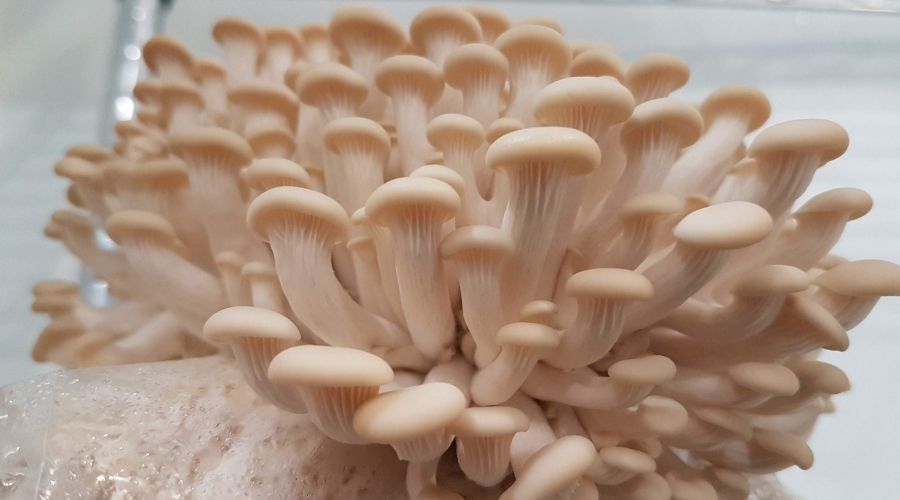
Although the elm oyster mushroom does grow on elm trees, “oyster” is a bit of a misnomer. This fungi isn’t a Pleurotus at all; its scientific designation is Hypsizygus ulmarius, which put it in the same genus as white beech mushrooms (Hypsizygus tessellatus, or buna shimeji).
Why is this “imposter” mushroom worth mentioning? For one, it has a lot of potential for indoor growing. It can tolerate high levels of carbon dioxide and doesn’t produce nearly as many spores as varieties like the blue oyster. The mushrooms are also edible, although the flavor differs from that of regular oyster mushrooms.
In the wild, Hypsizygus ulmarius prefers to grow high up on elm trees in dense clusters of large caps that can range from white to tan in color. Caps are typically between 6 cm and 15 cm (2.3 inches and 5.9 inches) but can grow up to 30 cm (11.8 inches).[3] Stems can grow quite long and thick, which further distinguishes the elm oyster from the majority of Pleurotus varieties.
Young elm oyster mushrooms have a light flavor and cook quickly. More mature specimens can be used in place of meat in vegetarian and vegan recipes.
Oyster Mushrooms Throughout History
So, where did all this ‘shroomy goodness stem from?
Dutch naturalist Nikolaus Joseph Freiherr von Jacquin was the first to identify the oyster mushroom in 1775, but he put it in the Argaricus genus, the same genus as button mushrooms! In 1871, German mycologist Paul Kummer reclassified the mushroom as Pleurotus, and it’s been at home in that genus ever since.[4]
First cultivated in Germany during World War I, oyster mushrooms are now grown as culinary mushrooms in countries around the world.[5]
A Tasty Culinary Heritage
You can find (or use) oyster mushrooms in a variety of regional cuisines, although they tend to star most often in Asian dishes.
Due to the meaty texture, they also make an appearance as a meat analogues in Czech and Slovak food. Vegetarians and vegans love them as seafood replacements; they can make for a pretty authentic clam chowder!
As a bonus, true Pleurotus mushrooms have several benefits for nutrition and overall health.
To Buy or to Grow?
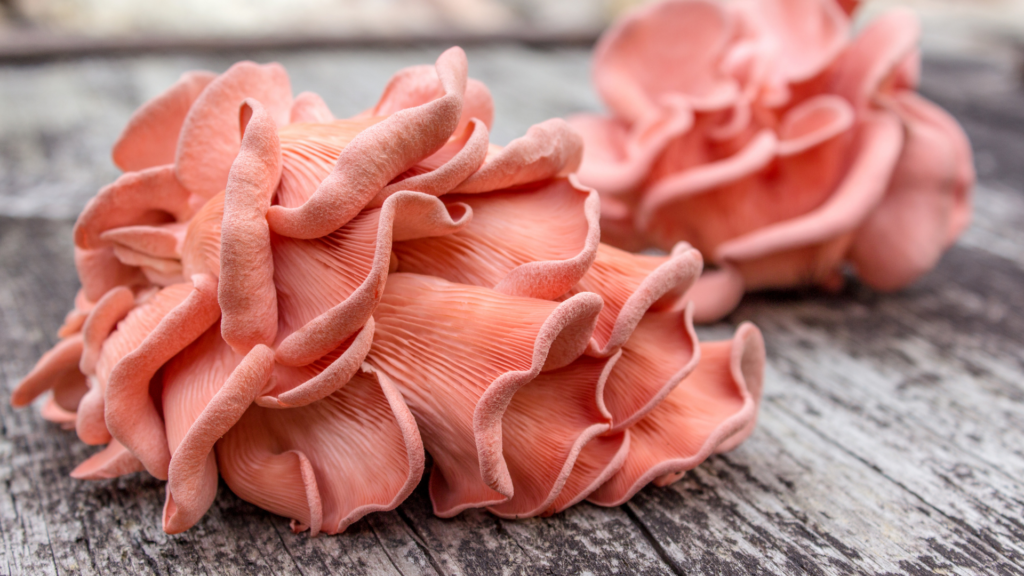
It’s getting easier to find Pleurotus ostreatus at grocery stores, but its unique cousins are a bit harder to get your hands on. Yellow, pink and blue varieties are rarely seen anywhere aside from their wild habitats and farmers markets. King oyster mushrooms are the exception; their hardiness and long shelf life makes them better candidates for retail sale.
For most culinary uses, traditional oyster mushrooms (and their fat-stemmed “king”) work just fine. Enjoy the flavor and texture wherever you’d use seafood, or get adventurous and try something new (like mushroom tacos).
If you want a continuous and reliable supply of the most delicate Pleurotus species and variants, growing them yourself is the way to go. They’re fairly easy for growers of all skill levels—and having your own mini mushroom farm right at home means you can always enjoy fresh mushrooms!
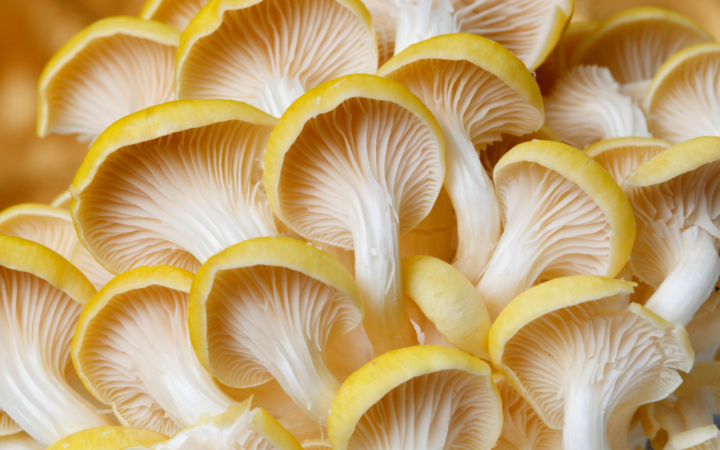
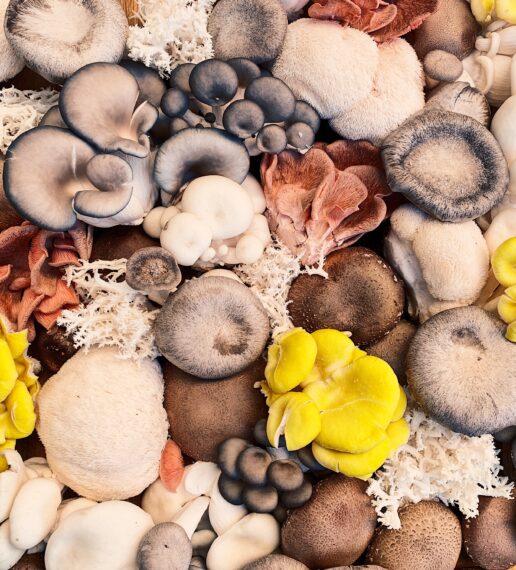

I’m intrigued, I just recently have been learning about edible mushrooms and after watching your video am now on a quest to find spores!!! Thank you for sharing.